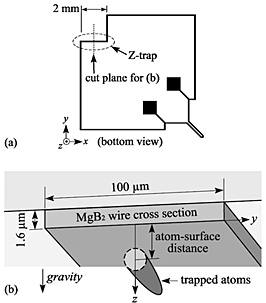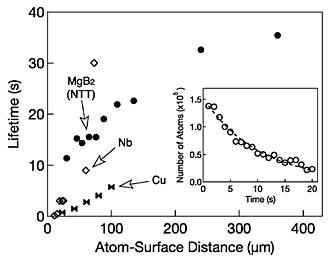Physical Science Laboratory
*The University of Electro-Communications / NTT Research Professor
Strong confinement in trapping neutral atoms is necessary to realize full
quantum control over atomic system. Although micro-magnetic trap on chip
is a promising candidate to realize a strong trapping confinement, the
electro-magnetic noise and thermal noise reduce the trapping lifetime seriously
in the vicinity of a chip surface. To overcome this problem we developed
a persistent supercurrent atom chip [1], and in 2008 we have shown an evidence
of noise-suppression of superconductive atom chip even in the vicinity
of a strip with large transporting current.
The experiment was done by measuring the number of atoms leftover after
keeping atoms in a chip potential with specific atom-surface distance.
An absorption measurement with reflected image was employed for precise
trap height identification (Fig. 1). The chip pattern that we used for
this experiment has an MgB2 superconductive loop circuit as shown in Fig. 2. Figure 3 represents the
measured trapping lifetime over the atom-surface distance, which was deduced
from the decay late of trapped atoms. The lifetime of our persistent supercurrent
atom chip was reaching more than an order longer than that of normal conductive
counterparts. With miniaturized wire strip, we will realize a strong trapping
confinement in quantum regime, and in future we will pursue the realization
of full quantum control over atomic system.
This research was partially supported by Japan Science and Technology Agency CREST.
[1] T. Mukai, C. Hufnagel et al., Phys. Rev. Lett. 98 (2007) 260407.
 |
||
|
 |
 |
|||||
|
|